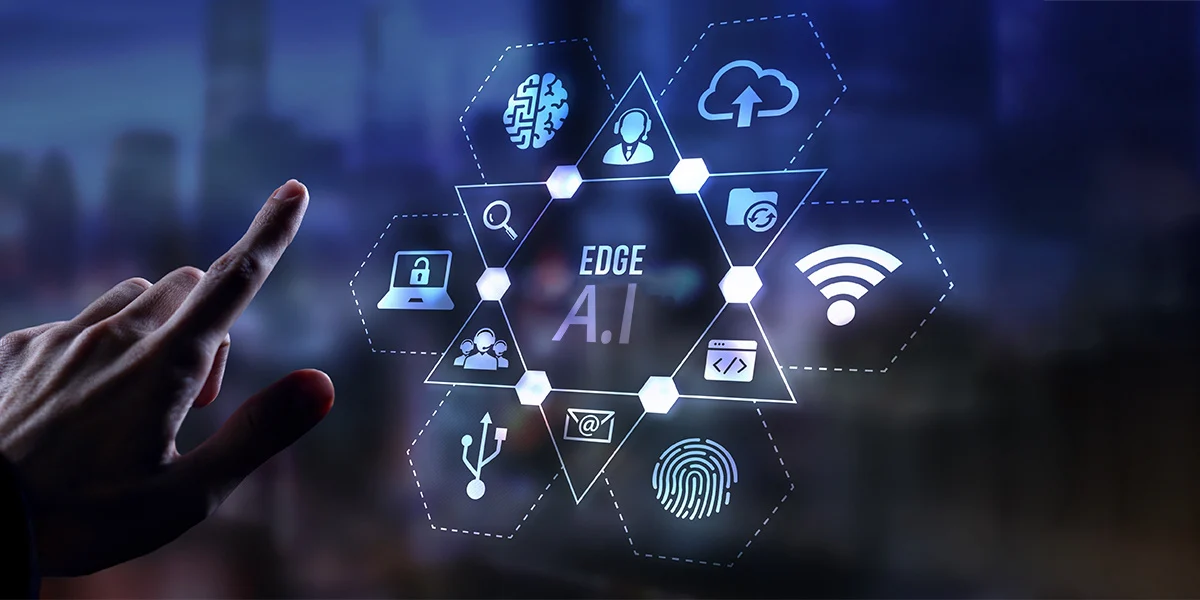Tech
Edge AI: The Next Big Thing in Smart Technology
Published
4 weeks agoon
By
IQnewswire
Artificial intelligence has come a long way in a short amount of time, changing industries and the way we use technology. But as AI systems get better, there is a greater demand for decisions to be made more quickly, more efficiently, and closer to home. This is where Edge AI comes in. Edge AI is different from typical cloud-based AI because it brings computing closer to the data source. This lets you analyze data in real time and make better decisions without having to rely on servers that are far away.
Moving to edge AI is more than just a technological improvement; it changes how people, businesses, and devices interact with smart systems. This page talks about what edge AI is, how it works, and the fields where it has the biggest effect.
Learning about Edge AI
Edge AI is when AI algorithms are put directly on local devices, such smartphones, sensors, cameras, or industrial machinery. Edge AI lets devices process information on-site instead of transferring it to a centralized cloud for processing. This cuts down on lag time, improves privacy, and speeds up the process of making decisions.
For example, a security camera with edge AI can see strange behavior happening right away and let the police know right away, without having to transfer a lot of video data to a server far away. Edge AI lets self-driving cars make judgments in a split second, which is important for safety and navigation.
How Edge AI Works
Edge artificial Intelligence is basically a combination of hardware and software that lets computers process data on their own. Devices have special chips built into them that can do complicated math. These chips are often termed AI accelerators. These chips are best for things like recognizing images, understanding natural language, and making predictions.
The software part has AI models that are meant to work well on hardware that isn’t very powerful. These models are frequently smaller copies of bigger neural networks, which lets them make smart choices without using too much power or memory. Edge AI systems can work without an internet connection since they have AI built right into the devices. They can also respond quickly to changes in the environment.
The advantages of edge AI
Edge artificial intelligence has benefits in many areas. One of the best things about it is that it lowers latency. It’s important for applications like self-driving cars, industrial automation, and robots that decisions can be made right away without using cloud servers.
Another big benefit is privacy. Sensitive data is processed locally, so it doesn’t have to be sent over networks. This lowers the chance of breaches or unwanted access. Edge AI also cuts down on cloud fees and bandwidth use because it only sends the data that needs to be stored or analyzed.
Edge AI also makes it easier to scale up. Devices with local intelligence can work in places where the internet is slow or not available at all. This makes it possible to work in fields like mining, agriculture, and environmental monitoring.
Uses of Edge AI
Edge AI is being used in a lot of different fields. Wearable devices can keep an eye on vital indicators in real time, find problems, and let doctors know without having to talk to the cloud all the time. Hospitals may utilize edge AI to keep an eye on how many patients are coming in and out, make better use of their equipment, and make care more efficient.
Edge AI powers smart cameras and sensors in stores that watch how customers act in real time. Stores can quickly change where products are displayed, make the checkout process better, and make the whole shopping experience better. Manufacturing businesses are also utilizing edge AI to keep an eye on machines, find problems, and stop downtime by analyzing sensor data on site.
Edge AI is also quite helpful for the car industry. Self-driving cars, driver assistance systems, and smart traffic management all depend on analyzing sensor data right away. Adding AI at the edge lets cars react right away to road conditions, barriers, and traffic signals, making them safer and more efficient.
Problems with Edge Artificial Intelligence
Edge AI has its own problems, even though it has some benefits. One of the biggest problems is that the gear isn’t powerful enough. Compared to cloud servers, devices at the edge frequently have less processing power and memory, which can make AI models less complicated.
Updating and maintaining models is another problem. To keep AI models accurate and safe, they need to be updated on a daily basis on thousands of edge devices. It might be hard and take a lot of resources to make sure that all the devices on a dispersed network work the same way.
Last but not least, careful planning is needed to combine edge AI with current systems. To get the best results while keeping prices low and data safe, businesses need to find a balance between processing data locally and in the cloud.
Future of AI on the Edge
Edge AI has a lot of potential, and it is projected to become more popular very quickly in the next few years. Devices will be able to do more and more complicated things thanks to improvements in hardware, such as AI chips that use less power. At the same time, better AI models that are designed for edge computing will make it possible for more industries and applications to use real-time intelligence.
Experts say that edge AI will be very important for the Internet of Things (IoT) since it will make homes, cities, and industrial systems smarter. Organizations will be able to get insights faster, make operations safer, and run more efficiently by merging local knowledge with cloud-based analytics.
Final Thoughts
Edge AI is a big change in how AI is used and implemented. Edge AI brings computing closer to the data source, which speeds up decision-making, improves privacy, and makes the cloud less necessary. The uses are already changing industries all across the world, from healthcare and retail to manufacturing and self-driving cars.
Edge AI will become more common as technology continues to improve. This will lead to smarter devices, more responsive systems, and a future where intelligent decision-making happens where it is needed most. Companies and developers that use edge AI now are at the front of this technological revolution and are ready to make the most of it.

How Local Couriers Support Small Businesses

Best Replica YSL Bag in Patent Leather

Put Pen to Paper: How Custom Notebooks Can Make a Lasting Impression

From Listing to Sold: Sell A Car in Perth Without the Stress

Unlocking the Benefits of Engineered Steel Solutions for Modern Construction

Discover the Ultimate Comfort and Style of Women’s Underwear in Australia

Unlocking Performance: The Ultimate Guide to Custom PC Builds with Centre Com

Unlocking Opportunities in General Practice Recruitment: A Guide by Global Medics

Hope & Kent: How Snow Removal Technology Is Reaching B.C.’s Most Challenging Terrains

Connecting the Dots in Recruitment: How Skima AI Integrates Seamlessly with Your Hiring Stack

Carol Kirkwood’s Journey: Her Real Age, Husband, Career, and More

Revolutionizing Healthcare: The Emergence of AI-Driven Analytics

How Machine Learning and AI are Redefining the Future?

Aliza Barber: Meet Lance Barber’s Wife, Age, Life, Profile, Career and Net Worth

Evelyn Melendez: Jordan Knight’s Wife Bio, Marriage, Family, Career and Net Worth

Ilan Tobianah Biography: Family, Marriage, Lifestyle, Career and Net Worth

Who was Alice Marrow? Everything to Know About Ice-T’s and His Mother

King Von’s Autopsy Report: The Truth Behind the Tragic Death

Meet Otelia Cox: The Supportive Wife of Tony Cox – A True Fairy Tale Romance

Tea Leoni and Tim Daly Split – A Closer Look at Their Relationship and Breakup

How Local Couriers Support Small Businesses

Best Replica YSL Bag in Patent Leather

Put Pen to Paper: How Custom Notebooks Can Make a Lasting Impression

From Listing to Sold: Sell A Car in Perth Without the Stress

Unlocking the Benefits of Engineered Steel Solutions for Modern Construction

Discover the Ultimate Comfort and Style of Women’s Underwear in Australia

Unlocking Performance: The Ultimate Guide to Custom PC Builds with Centre Com

Unlocking Opportunities in General Practice Recruitment: A Guide by Global Medics

Hope & Kent: How Snow Removal Technology Is Reaching B.C.’s Most Challenging Terrains

Connecting the Dots in Recruitment: How Skima AI Integrates Seamlessly with Your Hiring Stack
Category
Trending
-

 News2 months ago
News2 months agoCarol Kirkwood’s Journey: Her Real Age, Husband, Career, and More
-

 Health2 years ago
Health2 years agoRevolutionizing Healthcare: The Emergence of AI-Driven Analytics
-

 Technology2 years ago
Technology2 years agoHow Machine Learning and AI are Redefining the Future?
-

 Celebrity1 year ago
Celebrity1 year agoAliza Barber: Meet Lance Barber’s Wife, Age, Life, Profile, Career and Net Worth






